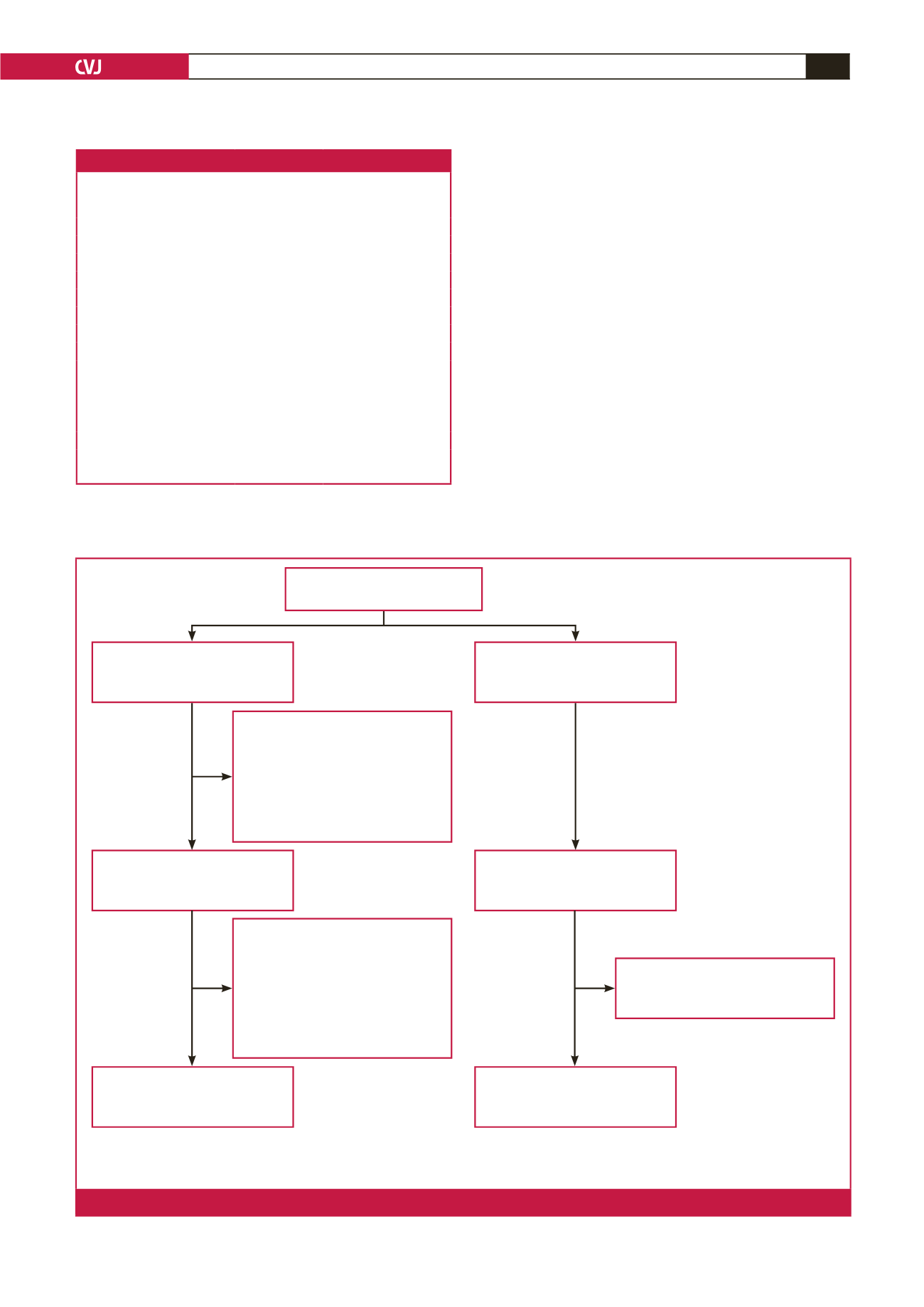

CARDIOVASCULAR JOURNAL OF AFRICA • Volume 26, No 4, July/August 2015
AFRICA
185
In the ICD group, there was 100% attendance for both cases
and controls at three months’ follow up. At the one-year follow
up, there was 100% attendance for the cases compared to 91.7%
for the controls, with one (8.3%) patient absent. However, this
patient had been discharged from Groote Schuur Hospital at
three months of follow up, to be followed in Port Elizabeth, and
was still alive at the time of publication (Fig 2).
Discussion
This study shows that the re-use of pacemakers and ICDs was
feasible and safe in our group of patients at Groote Schuur
Hospital in Cape Town, South Africa. There was no difference
in the incidence of device infection, malfunction, battery failure
or explantation due to complications between re-used and new
devices. Indeed, device implantation was associated with no
complications in this series.
To the best of our knowledge this is the second study ever
published of the outcomes of re-used ICDs.
24
In our study, there
were no identified device infections and/or devices explanted for
malfunction. There were no patients who were lost to follow up
in this group
Linde
et al
.,
22
in a retrospective case–control study, found no
significant difference in device infection, although paradoxically,
Table 4. Implantable cardioverter defibrillator parameters
Parameters
Patients with
re-used ICDs
(cases)
Patients with
new ICDs
(controls)
p
-value
VVI,
n
(%)
12
12
1.00
Minimum pacing rate, bpm 38.1
±
4.7
44.4
±
9.4 0.052
Ventricular pacing, %
12
12
1.00
Capture
Amplitude, V
Ventricular
0.618
±
0,28 0.708
±
0.32 0.481
Sensitivity, mV
Ventricular
12.925
±
6.93 16.118
±
6.17 0.258
Output
Amplitude, V
Ventricular
3.5 (3.3–3.875) 3.5 (3–3.5)
0.875
Electrode impedance,
Ω
Ventricular
784.75
±
304 648.83
±
147 0.177
V = volts; mV = millivolts; ms = milliseconds;
Ω
= ohms; K
Ω
= kilo-ohms;
A = amperes; bpm = beats per minute; VVI = single-chamber device.
Analysed (
n
=
126)
Pacemakers,
n
(%) – 102 (81)
• Re-used,
n
(%) – 51 (50)
• New,
n
(%) – 51 (50)
ICDs,
n
(%) – 24 (19)
• Re-used,
n
(%) – 12 (50)
• New,
n
(%) – 12 (50)
Did not follow up at 3 months,
n
(%):
• Cases: 25 (49)
–
–
Died – 11 (44)
–
–
Alive – 9 (36)
–
–
Unknown status – 5 (20)
• Controls: 8 (15.7)
–
–
Died – 1 (12.5)
–
–
Alive – 7 (87.5)
Seen at 3 months’ follow up,
n
(%):
• Cases: 26 (51)
• Controls: 43 (84.3)
Seen at 3 months’ follow up,
n
(%)
• Cases: 12 (100)
• Controls: 12 (100)
Did not follow up at 1 year,
n
(%):
• Cases: 32 (62.7)
–
–
Died – 15 (46.9)
–
–
Alive – 9 (28.1)
–
–
Unknown status – 8 (25)
• Controls: 13 (25.5)
–
–
Died – 3 (23.1)
–
–
Alive – 7 (53.8)
–
–
Unknown status – 3 (23.1)
Did not follow up at 1 year,
n
(%):
• Controls: 1 (8.3)
–
–
Alive – 1 (8.3)
Seen at 1-year follow up,
n
(%):
• Cases: 19 (37.3)
• Controls: 38 (74.5)
Seen at 1-year follow up,
n
(%):
• Cases: 12 (100)
• Controls: 11 (91.7)
ICDs
=
implantable cardioverter defibrillators
n
=
number
(%)
=
percentage
Fig 2.
Follow-up outline.

















